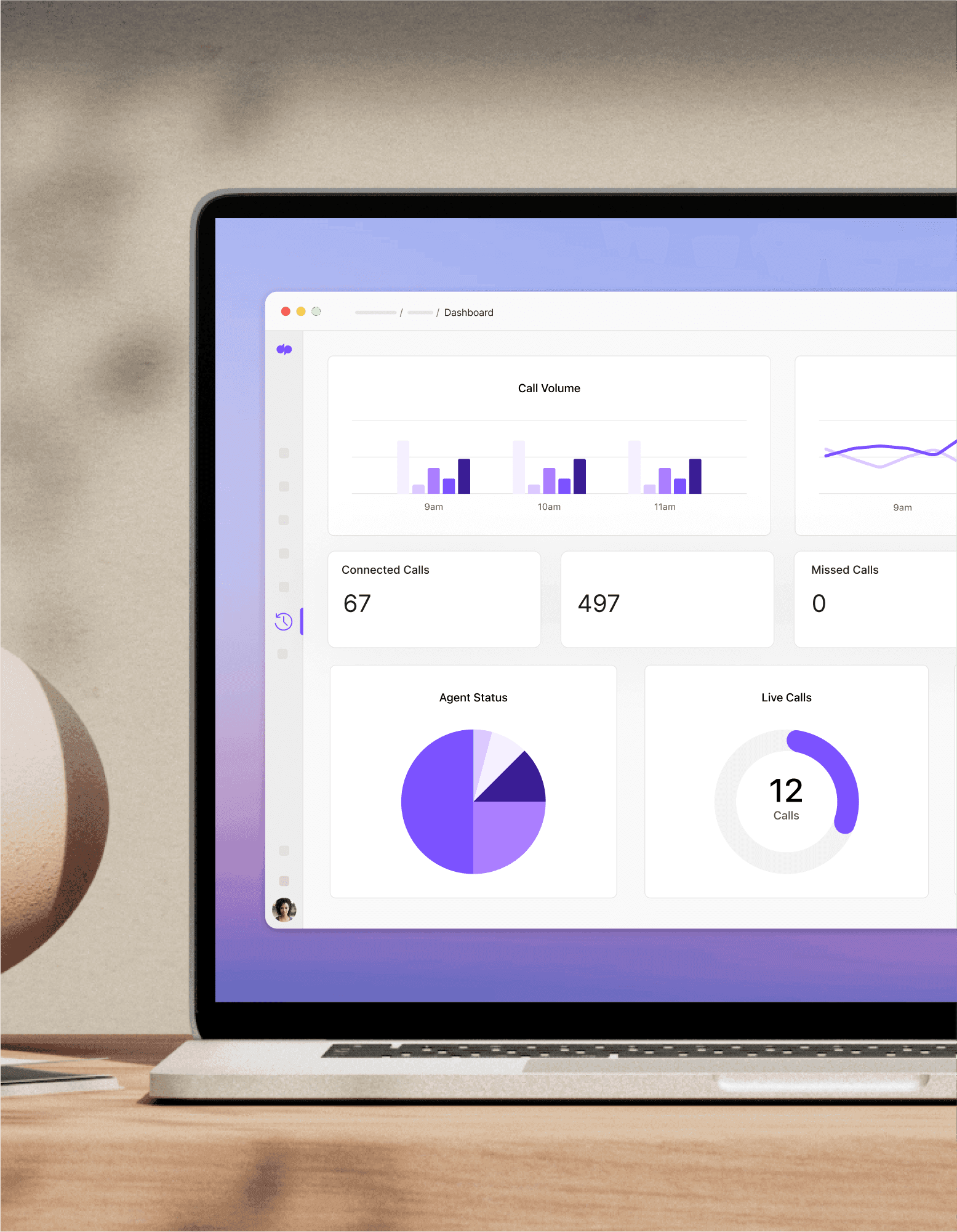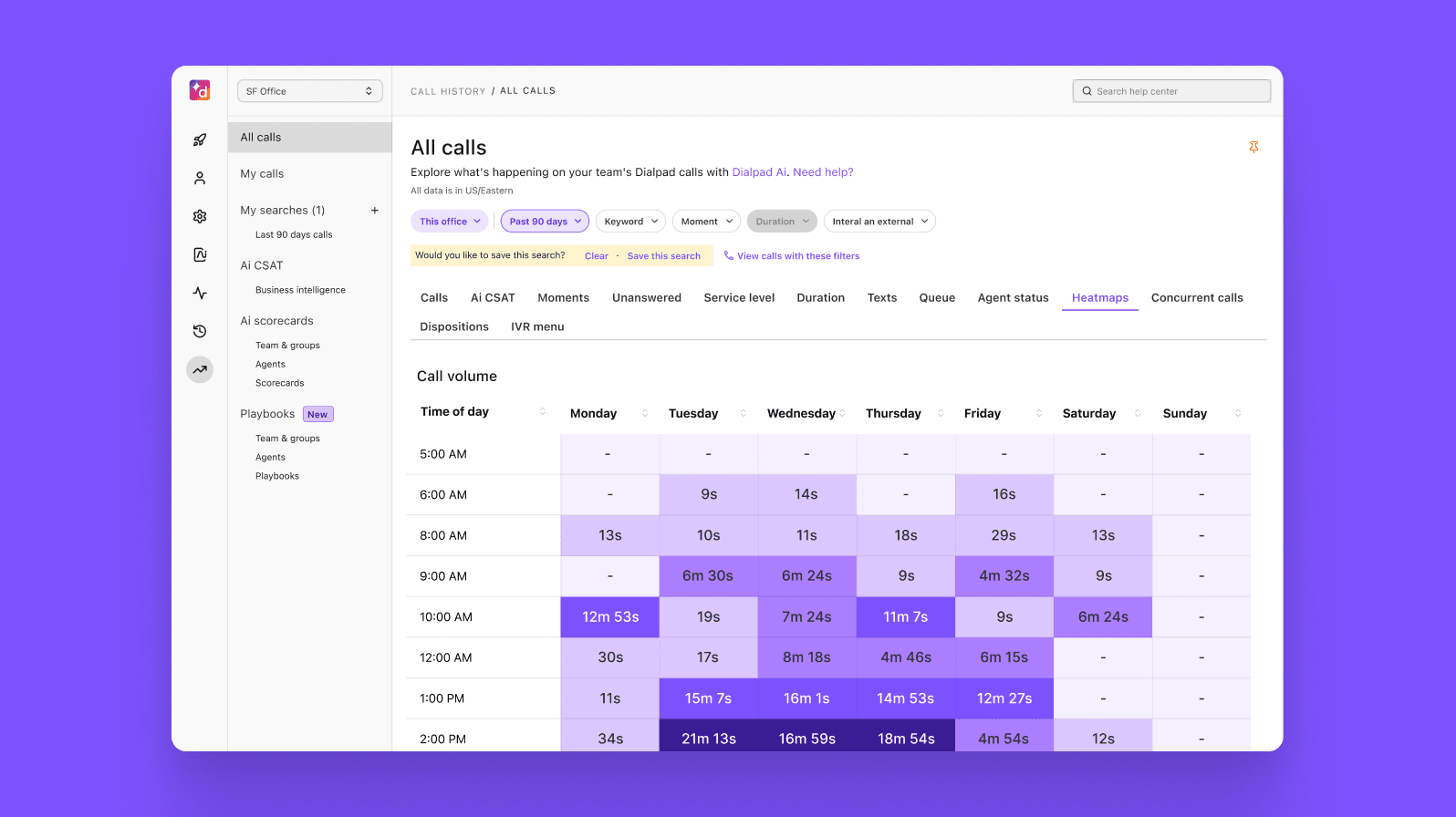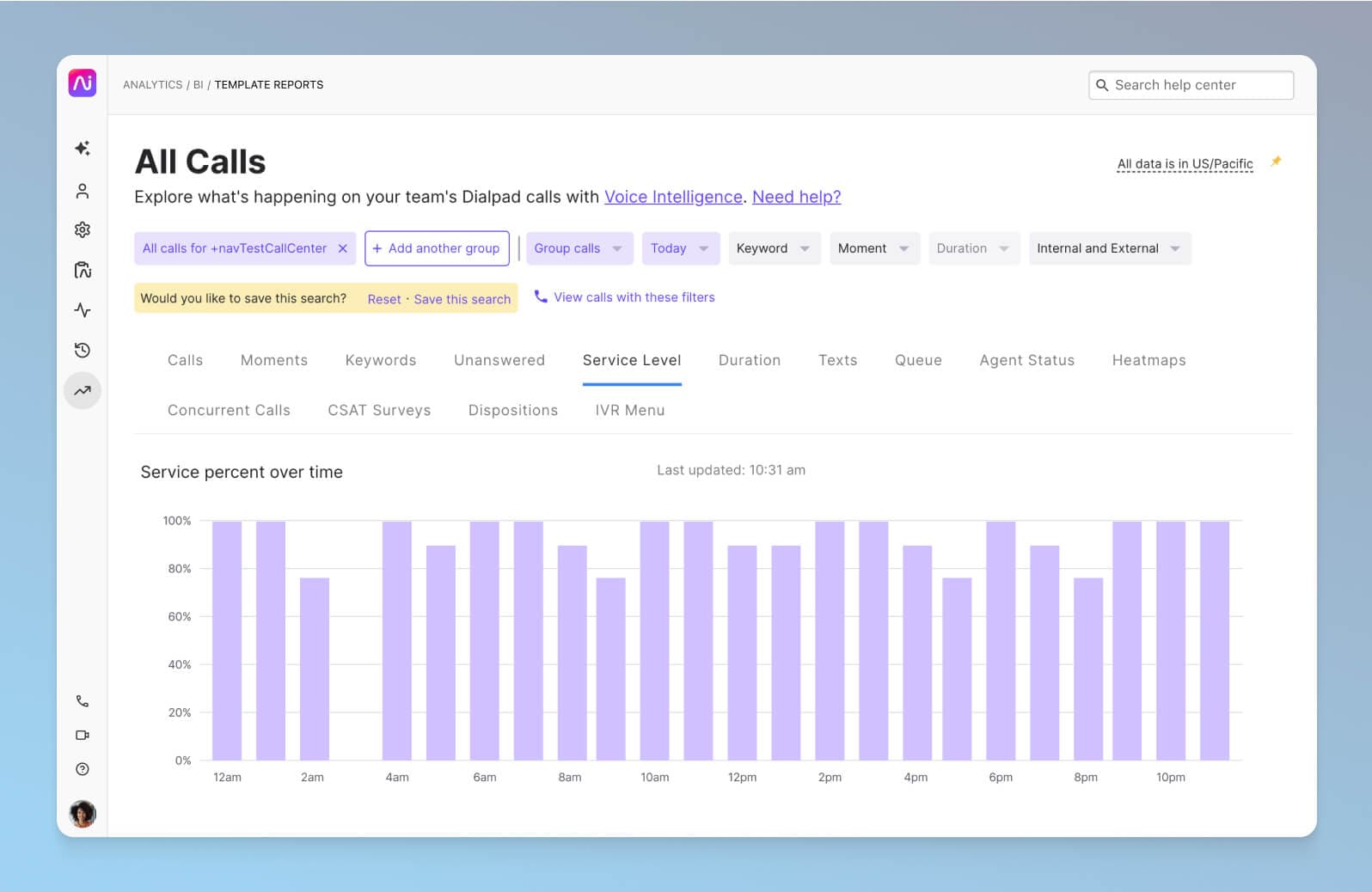Contact and call center forecasting
Learn about contact center and call center forecasting, and how to making more accurate and efficient staffing decisions. Or, if you're interested in seeing how Dialpad and Playvox's WFM solution integrate to give you a more robust customer engagement platform, book a personal walkthrough!

Wouldn‘t it be nice to have a crystal ball that helps you assign the right number of agents in your contact center that just perfectly lines up with your daily forecasts all the time?
Unfortunately, they don‘t make crystal balls like that yet, but you do have contact center forecasting, which can do almost as good of a job of helping you manage staffing and agent distribution effectively.
In this guide, we‘ll walk you through a few ways to improve your contact center forecasting and workforce management so that your teams can handle everything from unexpected call volumes to new product launches.
What is forecasting in a call or contact center?
Contact center forecasting refers to making accurate predictions about the volume of contacts your business is going to receive over a given time period, and by extension how you should staff your department with agents and supervisors. The purpose of this is to deliver the best customer experience possible, while accounting for spikes in inquiries, agents getting sick or taking time off, and so on.
Most contact center schedulers and managers will tell you that forecasting is a delicate balancing act between:
A: Ensuring you have enough agents to handle all your customer inquiries and
B: Controlling costs.
Basically, you need to channel your inner Goldilocks and find what’s “just right.” But this isn’t always an easy task.
What is contact and call center forecasting useful for?
Recruiting
Forecasting is crucial to your hiring strategy. How can you know how many agents you’ll need for the busy season, for example, if you can’t forecast those call volumes or contact volumes? Accurate forecasting can help you understand agent turnover patterns, seasonal needs, and ultimately reduce last-minute scrambles for hires.
By adopting forecasting as part of your hiring strategy, you’ll be able to:
Establish an efficient hiring culture
Increase your chances of hiring the right talent at the right time
Plan for future staffing needs
Develop internal talent more effectively
Identify key feeder roles
Scheduling
Perfect contact center scheduling is almost impossible to achieve. People will get sick, unpredicted events will continue to crop up, and changes to schedules are inevitable.
But, armed with accurate forecasts and projections, you can empower your contact center managers to create schedules that balance customer demand with a more efficient use of resources.
Task delegation
Much like scheduling, task delegation is much easier when we plan ahead. Let’s say we know that phone and live chat inquiries have historically spiked during the winter season. We can then place more agents on active duty on these platforms at this time of the year.
The Dialpad + Playvox integration is designed to help with agent scheduling and contact center management, giving supervisors fully integrated WFM (workforce management) capabilities inside Dialpad:

3 traditional call center forecasting methods
Implementing workforce management software in a contact center is a pretty big investment in time, dollars, and human resources. And if you‘re still deciding whether this investment is worth it, don‘t worry—this is definitely something to look beyond the short term and do due diligence for.
In the mean, here are a few forecasting techniques and KPIs you can use while you decide on the tech stack that’s right for your agents and supervisors.
Triple exponential smoothing
Exponential smoothing is a statistics-based method used to make accurate long-term forecasts from data sets. (Skip this if you‘re looking specifically for daily forecast methods.) Here, you‘re using past data to make predictions for the next business period and this method can work with any number of data sets (e.g., the number of calls or contacts per week, month, or year).
Let’s say you have data on chatbot contacts for the past three weeks. Your exponential smoothing formula would look like this:
Next week’s volume = ½ of last week’s volume + ¼ of volume from two weeks ago + ⅛ of volume from three weeks ago.
Triple exponential forecasting takes into account three data components: levels (contact volumes), trends (how volumes fluctuate according to period), and seasonality (how the time of year impacts volumes). In triple exponential forecasting, all three aspects of any data set are accounted for.
ARIMA
ARIMA (autoregressive integrated moving average) is a statistical analysis model based on time series data. ARIMA uses historical data to generate forecasting models that explain present data sets based on past data sets.
In other words, ARIMA compares real-time data with data from previous periods and smooths it out using lagged moving averages to increase your forecasting accuracy.
Neural networks
It’s time to talk a bit more about artificial intelligence. Neural networks are AI-powered machines that actually mimic the structures and patterns of human neurons in the brain. Neat, right? A neural network system processes big data sets from multiple inputs.
The more data you put in, the more accurately the system can identify trends and make future predictions based on that data. Neural networks even recognize individual events and external factors like holidays or marketing campaigns that impact demand. They do, however, require significant processing power, often using a GPU (Graphics Processing Unit).
A forecasting calculator for your call or contact center: The Erlang C formula
More commonly than using one of the above forecasting methods, businesses may choose to use the Erlang C formula for their contact center forecasting. This calculation quantifies the number of staff you’ll need for any given number of contacts in order to meet a set service level.
Fun fact: The calculation was first thought up by a Danish mathematician called A.K. Erlang.
If you’re using an Erlang calculator this is pretty straightforward. All you have to do is enter an input (e.g., the number of contacts received in a period of time), along with your average call duration, and your desired service level. The Erlang calculator will then output the number of agents needed to meet your personal targets.
Erlang calculators are available in two formats: Excel and online. Let’s take a look at the pros and cons of the two:
Excel-based
One way to perform an Erlang calculation is using Excel. Excel worksheets use macros, add-ons, or automated input sequences to perform complex calculations. Excel has lots of advantages; it’s super flexible and easy to build small-scale WFM systems on the platform.
On the downside, Excel is best suited for performing Erlang calculations for smaller organizations (around 500 agents maximum). On top of that, manual spreadsheets can be vulnerable to human input error and don’t always take call center shrinkage into account.
Online-based
The second option is an online Erlang calculator. These tools are super accessible, and many are available for free online without the need to download software to your PC or devices.
Online calculators are a better option for larger teams, and some online Erlang calculators will perform calculations for groups of 700+ agents. The only problem is that not all online-based tools will conduct robust quality checking, which can increase the risk of error. These tools may not take shrinkage into account either.
Choosing contact or call center forecasting software: What to look for
Now that we've looked at some of the more traditional methods of call center forecasting, let's look at how software can make this process easier.
Real-time monitoring and reporting
A good contact center forecasting software solution needs to include robust monitoring and reporting tools. This is what will give you visibility into core metrics like handle time and average speed of answer.
Keep in mind that not all contact center or call center software comes with built-in analytics. An example of one that does is Dialpad's AI-powered customer engagement platform, which comes with dashboards and heat maps that show you metrics like call volume patterns and average speed to answer:

Dialpad’s real-time analytics reports show us how our agents are doing by department, by date, and even by service level. It helps us increase customer satisfaction and decrease the time we take to deliver solutions.
Tania Cardenas
Senior Sales and Operations Manager at Camino Financial
AI-based forecasting
Artificial intelligence can save you quite a bit of time by helping to automate the forecasting process and produce long-term demand and performance predictions, even while taking seasonality into account. Using an AI-enabled contact center forecasting tool, you can continuously track variations in seasonality and make targeted business adjustments accordingly.
For example, Dialpad integrates with Playvox to offer AI-powered WFM and forecasting functionality for call centers—that can self-adjust (thanks to AI) to improve accuracy!
Integrations
Integrations are critical. If your software can “talk to“ each other, that means they can do things like automatically sync data (like agent calls and other activities) between each other without you manually having to do anything.
For example, Dialpad integrates with tools like Playvox, a WFM or workforce management tool that‘s specifically designed to help with staff forecasting, intra-day management, scheduling, and more.
In fact, businesses like Smart Autocare are using Dialpad + Playvox to help staff their contact centers more efficiently. Smart Autocare has remote employees in 12 states across different time zones, and it’s using the Dialpad and Playvox integration to do AI-powered forecasting based on real-time data from phone, chat, and even their social media channels to make sure their contact center is properly staffed at all times.
Real-time data is invaluable, it really is. We can staff appropriately and can change over or move people quickly, which is something we’re working on in Dialpad.
Lance Schley
Director of Call Centre Operations
Now, they can quickly identify when they have a long wait on phone lines or backed up emails, so they can move people where they’re needed in real-time. “Without [Dialpad and Playvox], we’d be stuck wondering what’s going to happen the next day,” says Lance.
5 best practices for effective contact center forecasting
Choosing the right call center forecasting software is only one part of the puzzle. Here are some best practices to use in conjunction with a good contact center or customer engagement solution.
1. Identify your most important metrics for forecasting
The first rule of forecasting is to know your metrics. There are three core metrics that all contact centers should be aware of (even if they‘re not using them) when it comes to forecasting:
Call volume: The number of inbound calls you receive during a given period
Average handle time: The amount of time taken for an agent to complete a call
Service level goal: How many calls you want answered in a given time period. Some call center or contact center platforms, like Dialpad Support, have a feature that automatically notifies supervisors or managers when service levels dip below a certain threshold:

Once you’ve got a handle on these three core metrics, you can look at introducing a wider range of contact center forecasting metrics into your planning process. A few more metrics to consider:
Schedule adherence: The amount of time an agent spends working as a percentage of the total time they’re scheduled to do so.
What it indicates: Efficiency. A lower adherence rate is a sign that agents are not as productive as they could be—or that you have too many agents.
Fun fact: The Dialpad + Playvox integration shows you this right in the dashboard:

Cost per contact: Total spend for each contact with a customer, including operational expenses and employee wages.
What it indicates: Efficiency. A lower cost per contact rate suggests that you’re staffing efficiently and your agents are working efficiently.
Attrition rate: The rate at which employees are lost through resignation, retirement, or termination.
What it indicates: Employee experience, hiring needs.Tracking attrition helps HR develop a long-term staffing strategy and ensures that lost agents are always replaced with new agents in a timely manner. A high level of resignations might also indicate agent dissatisfaction and warrant an investigation into employee welfare, the support and training they’re getting, and your company culture as a whole.
2. Have a failsafe process in case of unforeseen schedule changes
Remember that no matter how accurate your forecasting is, schedule changes are an inevitability. Most forecasting strategies operate within the bounds of “normal” operations, but the reality is that every day is different and unexpected circumstances are bound to crop up now and then.
Because of this, it’s important that we design processes that account for both recurring and non-recurring events. Likewise, staffing plans should be drawn up with a degree of flexibility to reduce commercial impact when things don’t go quite to plan. For example, when advisors call in sick or get held up, or when more serious disruption occurs.
3. Identify the factors that cause overstaffing and understaffing
We’ve already discussed how contact center forecasting can help us more accurately predict staffing needs based on demand. But what about the factors that actually cause overstaffing and understaffing in the first place?
It’s important to consider these factors too before deciding on a staffing quota. It’s never possible to get your staffing levels 100% accurate. For example, if your bottom line is the priority and you think your numbers might be tight this quarter, then you might prefer to risk under-staffing until the end of this quarter. Or, if outstanding service is more important to you, then you’ll want to lean towards moderately overstaffing your contact center. Both of these come with their advantages and disadvantages, so your decision will depend on your business’ specific needs.
4. Leverage your historical data for more accurate forecasts
Forecasting relies on past data to make predictions for the future—which means that before you implement a forecasting strategy for your contact center, you should have a record of historical data from previous years.
Whichever short-term or long-term forecasting method you choose, whether it’s a manual calculation or an automated process, you need to have this data because it’s going to reveal those all-important patterns and trends that will inform your future planning.
5. Tailor your forecasting to different channels
If you‘re a contact center manager, your job is a bit more complicated than a call center manager‘s. Why? Well, unlike traditional call centers, contact centers do a whole lot more than just take phone calls.
So, don’t limit your contact center forecasting to just call volume predictions. Instead, make sure that your forecasting methods take into account the specific needs of each communication channel, like the phone, live chat, social media, chatbot, and so on.
That way you’ll not only be able to staff your contact center with the right number of agents to meet demand, but you’ll also be able to delegate these agents to the channels that need them most at any given time.
(For instance, if live chat demand is higher than phone call demand on Friday afternoons, then it makes sense to have more agents on live chat during this period.)
Improve your workforce management with call and contact center forecasting
Hopefully this guide has given you insight into the nuances of contact center forecasting and some ideas for how you can achieve more accurate weekly and daily forecasts.
Forecasting is about so much more than just predicting how many customer interactions you’re going to manage each day. It also involves optimizing your agent scheduling, task allocation, and overall workforce management, which together can help you provide better employee and customer experiences.
With the Dialpad + Playvox integration, you get targeted forecasting and WFM capabilities built-in alongside your everyday must-have contact center functionality. See how it works!
Want to have more accurate contact center forecasting?
Get a walkthrough of how Dialpad's Playvox integration works! Everything you need is in one platform, which means less toggling back and forth for your agents, and less time and resources spent on administering a bunch of disparate tools.
